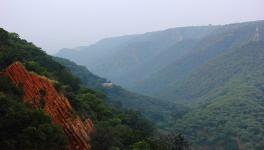Taking Stock of India’s Himalayan Crisis
The vast green cover of the Himalayan range has been an eco-service provider for India and all countries around its mountain chains. Combined with the Karakoram region, it has the largest volumes of snow and ice outside the polar regions. The Himalayan region is the source of major Asian rivers and a regional and global climate regulator. Yet it is also a fragile ecosystem where a great deal of anthropogenic activity takes place. The biggest source of disruption to this delicate region over the last decade has been the race to build infrastructure, especially hydropower projects, roads, airstrips, railways and tunnels, even in the higher mountain reaches.
What we can look back to over the last decade in this region is incessant activity, often sanctioned despite warnings about melting glaciers and disappearing permafrost. This development pattern is self-destructive, considering Earth’s rising temperatures. There are already over 1,500 dams, functioning or under construction, in India, China, Bhutan, Nepal and Pakistan. Scientists warned over a decade ago in a study published in the journal Conservation Biology that the Himalayan region will soon have the highest dam density—one dam per 32 kilometres of river channel—most of them in areas known for high species diversity, such as Sikkim. Some parts of India had already overtaken the global dam intensity metric when the widely-reported study was published. Conducted by the Centre for Inter-disciplinary Studies of Mountain and Hill Environment at Delhi University and R Edward Grumbine of the Kunming Institute of Botany, China, this report analysed the impact of 132 of the 292 dams in the Indian Himalayas at the time.
It hardly needs mention that the best practices are still being ignored in the construction and development of these regions, and the tiny state of Uttarakhand has been bearing the brunt of this. According to the Forest Survey of India 2019, between January 2015 and February 2019, over 2,800 hectares of forest land were diverted for non-forestry purposes under the Forest Conservation Act of 1980. In 2014-15, nearly 64% of the land in Uttarakhand was forest. In the 2019 report, this had slipped to just below 565 of the land area. Today, metal roads in Uttarakhand alone cover 40,000 kilometres of route. The problem is that many roads, like those under the 900-kilometre Char Dham project, have had experts warn of violation of environmental norms and well-laid conservation strategies and plans of successive governments. The Char Dham project envisages four-laning from the plains to the religious sites at Gangotri, Yamunotri, Badrinath and Kedarnath, a process involving cutting slopes vertically, resulting in destabilised slopes.
The Union Ministry of Science and Technology had in June 2010 released a document emphasising the need to build roads fully compliant with the Himalayas’ fragile environment. This report was prepared as part of a “national mission” to sustain the Himalayan ecosystem, but the government itself flouts warnings in such documents in favour of unscientific road widening, leaving people to cope with the catastrophic consequences.
The result is eight landslides per day and tremendous hardship for pilgrims and tourists alike. One of the worst was in June, near Pithoragarh on the border with China, which left 300 tourists stranded for five days and nights. The Char Dham project has seen several tourists die in landslides. In 2020, the National Crime Records Bureau recorded 264 deaths from cyclones and landslides the previous year; landslides were the dominant cause of death in Mizoram, Arunachal Pradesh, Kerala and Uttarakhand.
Dam construction is also causing irreversible damage to India’s hilly and mountainous terrain. No town symbolises this better than Joshimath, also in Uttarakhand, whose residents blame the National Thermal Power Corporation’s Vishnugad-Tapovan hydropower project for damaging their homes and livelihoods. Blasting work on the Tapovan tunnel had been on for over two decades when there was a sudden significant subsidence in the dwellings and roads of the area in 2022.
The local and state authorities ignored the residents’ complaints about subsidence for years and ultimately resorted to demonstrations. The National Remote Sensing Centre confirmed that Joshimath had sunk 9 cm between April and November 2022 and 5.4 cm over just 12 days in January 2023.
But Joshimath is not the only city facing this problem. Geologist Prof SP Sati points out that cities are sinking across Uttarakhand from Nainital, Uttarkashi, Bhatwari, Gopeshwar, Guptkashi, and Karnpragyag to Mussorie, where homes and hotels have developed cracks. The problem is spreading to different parts of the country, as reports show, including Jammu and Kashmir, and it is unfair and incorrect to call these incidents “natural” disasters or “acts of god”, since it is caused by poor planning and unscientific development.
Like many geologists, Sati blames tunnelling for the Rishikesh-Karnprayag rail project and the use of dynamite on the Char Dham project.
Dr C P Rajendran, adjunct professor at the National Institute of Advanced Studies, Bengaluru and an expert on earthquakes, has frequently warned against the large-scale infrastructure projects (66 tunnels and over 200 dams under construction in Uttarakhand) that risk the fragile ecosystem of the small hilly state. He believes the 125 km rail track (105 km will be tunnelled) adversely impacts Himalayan tectonics.
“There is a belief that building tunnels may decrease the impact of infrastructure on the environment. But these subsurface structures could result in gross damage to the environment,” says Rajendran.
“Rail traffic may rely on electric locomotion, but constantly generated vibrations during train movement in tunnels would also weaken rock formations, leading to landslides besides generating a huge waste,” he explains.
Rajendran and other scientists warn that the Himalayan environment—including in China, Nepal and Bhutan—is on the brink of collapse and may not withstand another anthropogenic push. Massive construction in semi-permafrost leads to landslides and avalanches in all these countries. In Pakistan, the Shispir glacier in Gilgit Baltistan has been melting due to global temperature rise, creating unstable lakes. There was a massive spillover in May 2022, in which a historic bridge on the Karakoram Highway was damaged, apart from houses, agricultural land and two hydropower projects destroyed.
In February 2021, part of the Nanda Devi glacier broke off, triggering a massive flash flood in the Rishiganga River, destroying two hydropower projects and causing the death of 200 workers, most trapped in an under-construction.
In winter 2021, which was unusually warm, avalanches, usually expected in March-April, occurred in February. Extreme weather is frequent, while hazardous construction amplifies problems in eco-sensitive regions.
Against this backdrop, scientists worldwide are urging the Himalayas to be declared an international biosphere reserve where no hazardous or anti-ecological activity is permitted. The people in these countries are highly vulnerable to climate change effects, and it seems India is jeopardising their future for short-term gains. All efforts should be made to reverse this trend and strengthen our vulnerable ecosystems.
The author is a freelance journalist. The views are personal.
Get the latest reports & analysis with people's perspective on Protests, movements & deep analytical videos, discussions of the current affairs in your Telegram app. Subscribe to NewsClick's Telegram channel & get Real-Time updates on stories, as they get published on our website.
























